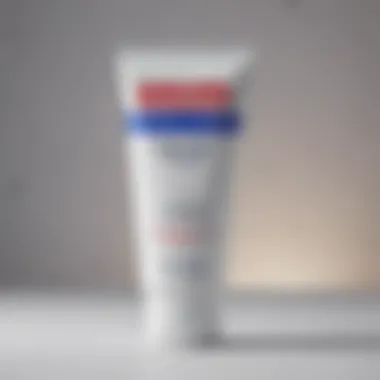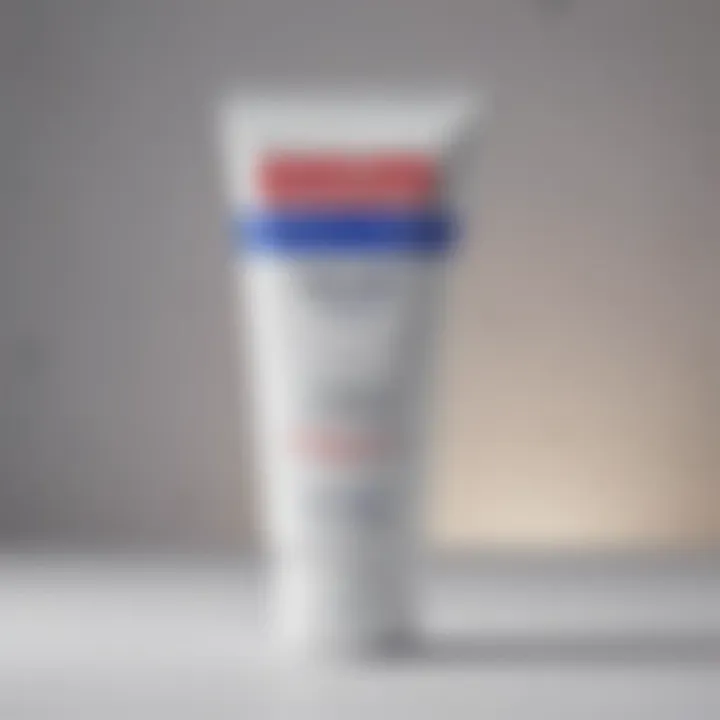Best Toothpaste for Fast Teeth Whitening


Intro
In today's beauty landscape, an attractive smile often symbolizes health and confidence. However, many individuals find themselves grappling with the challenge of maintaining white teeth. This concern has led to a growing interest in the various toothpastes specifically designed for rapid whitening. Among diverse products available, choosing the right toothpaste can be overwhelming. Thus, this article aims to dissect the most effective options, highlighting key ingredients and brands that warrant attention.
The significance of toothpaste in the teeth whitening process cannot be understated. Certain formulations contain active ingredients that target stain removal and surface whitening. Additionally, the influence of consistent oral care plays a pivotal role in enhancing the longevity of results. Readers will learn to navigate common myths related to whitening toothpaste and appreciate the necessity of a well-rounded dental hygiene routine as part of an overall beauty regimen. As this guide unfolds, it seeks to empower readers with knowledge and informed choices for their dental care.
Understanding Teeth Whitening
Understanding teeth whitening is essential for anyone interested in enhancing their smile. It involves the process of removing stains and discoloration from teeth, leading to a brighter appearance. Over time, teeth can become stained due to various factors, such as diet, lifestyle, and natural aging. Knowledge of teeth whitening not only helps individuals make informed decisions about products but also allows for a more effective approach to achieving desired results.
The significance of understanding teeth whitening extends beyond aesthetics. A bright smile can boost self-confidence and contribute positively to personal and professional interactions. Moreover, some whitening products might not be suitable for everyone; thus, it is crucial to recognize the specific needs of one's teeth.
Types of Teeth Staining
Teeth staining generally falls into two categories: intrinsic and extrinsic.
- Intrinsic stains originate from within the tooth. They are often caused by factors like aging, certain medications, or excessive fluoride exposure during childhood. These stains are typically more challenging to remove than surface stains.
- Extrinsic stains, on the other hand, are found on the outer surface of the teeth. They can result from food, drink, smoking, or poor oral hygiene. Coffee, tea, red wine, and berries are common culprits for extrinsic staining.
Recognizing the type of staining is crucial. For example, an extrinsic stain may respond well to whitening toothpaste, while intrinsic stains might require professional treatments for effective removal. Understanding these differences allows for targeted approaches to treatment and better outcomes.
How Teeth Whitening Works
Teeth whitening primarily operates through two mechanisms: bleaching and non-bleaching methods.
- Bleaching agents typically contain hydrogen peroxide or carbamide peroxide. These chemicals penetrate the enamel and dentin to break down stains. The strength and concentration of the bleach affect both the effectiveness and safety of the whitening process. Most over-the-counter whitening toothpastes contain lower concentrations of these agents, making them suitable for regular use.
- Non-bleaching whitening agents often utilize abrasives or other chemical agents that polish the teeth instead of bleaching them. This process can effectively reduce surface stains but may not provide as dramatic results as bleaching methods.
In both cases, the goal is to remove or lessen the appearance of stains. However, it is essential to follow product instructions carefully to avoid any potential side effects, such as enamel erosion or increased sensitivity.
Understanding teeth whitening processes allows individuals to choose suitable products tailored to their needs and achieve the desired outcomes safely and effectively.
Criteria for Selecting Whitening Toothpaste
When it comes to achieving a bright smile, not all whitening toothpastes are created equal. Selecting the right product is crucial for effectiveness and safety. This section will highlight the essential factors to consider when choosing a whitening toothpaste. By understanding these criteria, readers can make informed decisions that align with their dental health needs and aesthetic goals.
Active Ingredients to Look For
Effective whitening toothpastes often contain certain active ingredients that significantly contribute to the reduction of stains on teeth. Here are some common active agents:
- Hydrogen Peroxide: Known for its bleaching properties, this ingredient penetrates the enamel to break down stains.
- Baking Soda: A mild abrasive that can help remove surface stains without damaging the enamel.
- Calcium Carbonate: Another abrasive that can effectively lift stains while being gentle on teeth.
- Charcoal: Some products use activated charcoal to absorb stains, but this can be abrasive for some users.


Readers should choose toothpastes boasting these components, as they are backed by research. It's also beneficial to check for the concentration of these ingredients. Generally, products with 1-1.5% hydrogen peroxide are considered effective for home use.
Sensitivity Considerations
Tooth sensitivity is a common concern when using whitening toothpastes. Many individuals experience discomfort when certain ingredients come into contact with their teeth. It is essential to consider this aspect before making a purchase. Here are some helpful points:
- Sensitivity-Focused Formulas: Brands like Sensodyne offer formulas designed for sensitive teeth. These toothpastes contain potassium nitrate or strontium chloride, which can alleviate discomfort.
- Monitoring Usage: Usage frequency is vital. Using whitening toothpaste more than recommended can lead to increased sensitivity. It is advisable to follow the manufacturer's instructions.
- Professional Consultation: Consulting a dental professional before starting any whitening regimen can help identify suitable products and methods, especially for those with pre-existing dental issues.
"Choosing the right toothpaste is as important as good oral hygiene itself. It can enhance results and protect against sensitivity."
Top Brands of Whitening Toothpaste
When it comes to achieving a brighter smile, the toothpaste you choose plays a prominent role. Not all whitening toothpastes are created equal. Different brands offer various effective formulas designed to target specific types of stains. Understanding the top brands is crucial for women seeking rapid teeth whitening. This section highlights notable brands known for their efficacy, ingredient transparency, and user satisfaction. The importance of brand reputation can not be overstated, as it reflects research and development investment. In addition, well-known brands often provide clinical evidence supporting their claims.
Brand A: Product Overview
Brand A is widely recognized for its advanced whitening technology. It utilizes hydrogen peroxide as an active ingredient, which has been proven to penetrate enamel and lift stains effectively. This toothpaste also contains fluoride, aiding in the prevention of cavities. Customers often praise Brand A for its noticeable whitening effects within a short period. While some users report a slight sensitivity, most find it manageable. Its packaging is user-friendly, making the application routine straightforward. Overall, Brand A positions itself as a reliable choice for those needing fast results.
Brand B: Product Overview
Brand B takes a different approach by focusing on natural whitening agents. It contains baking soda and activated charcoal, both known for their stain-removing properties. This toothpaste aims to deliver minimal abrasion while still achieving a brighter appearance. Many users value its more gentle formula, declaring it suitable for sensitive teeth. Additionally, the absence of harsh chemicals appeals to health-conscious individuals. Brand B is an attractive option for those preferring a less conventional, enamel-friendly method of teeth whitening.
Brand C: Product Overview
Brand C is well-regarded for its complete oral care system integrated with whitening features. This toothpaste contains a combination of silica and stain-fighting enzymes, which work together to eliminate surface stains. Brand C emphasizes long-term care by providing additional benefits such as gum health improvement and breath freshening. Users often appreciate its minty flavor, which provides a refreshing aftertaste. This brand is a strong contender for individuals looking for a holistic approach to dental hygiene while pursuing a whiter smile.
Effectiveness of Whitening Toothpaste
Understanding the effectiveness of whitening toothpaste is crucial as it represents a significant aspect of oral hygiene and aesthetics for many individuals. This assessment not only highlights how these products function but also provides insights into their impact on overall dental health. For those seeking a brighter smile, knowing the effectiveness of whitening toothpaste can facilitate informed decisions when navigating options available in the market. Furthermore, it can shed light on realistic expectations regarding results and timeframes when using these products.
Clinical Studies and Results
Clinical studies serve as a solid foundation for evaluating whitening toothpastes. Research has shown that many whitening toothpastes contain active ingredients such as hydrogen peroxide or carbamide peroxide. These ingredients are scientifically proven to assist in breaking down stains on the enamel and dentin layers of the teeth. For example, a clinical trial published in the Journal of Dentistry highlighted that toothpaste containing 3% hydrogen peroxide resulted in noticeable whitening in participants after four weeks of use.
In addition to peroxide-based formulations, some studies have investigated the efficacy of other agents like silica and baking soda. Silica abrasives work to physically remove surface stains, while baking soda can neutralize acids and promote a generally healthier mouth. Both methods have shown positive results, though individual experiences may vary based on many factors such as the extent of staining, enamel health, and user compliance in following the recommended brushing practices.
Research also suggests that while whitening toothpastes may provide some degree of whitening, effects may be subtle compared to professional treatments. Users must keep in mind that toothpaste is often less effective on intrinsic stains, which are deeper than what surface treatments can reach.
User Experiences and Testimonials
User testimonials can provide valuable insight into the effectiveness of whitening toothpaste. Many individuals report varying degrees of success with different brands. Some users have shared positive experiences, noting a noticeable change in tooth color after a few weeks of consistent use. Others, however, have expressed disappointment, stating that they observed little to no change. Such variability can stem from different factors:


- Duration of Use: Frequency and period of consistent brushing play a role.
- Initial Stain Level: Those with severe discoloration might not achieve the same results as those with minor staining.
- Sensitivity: Some users report increased tooth sensitivity during or after using whitening toothpaste, which could deter continued use.
A review of discussions on platforms like Reddit showcases diverging opinions about specific brands. Some users commend brands such as Colgate Optic White for immediate effects, while others favor Sensodyne for its gentler approach. Overall, it seems that users appreciate a product that yields gradual improvements combined with minimal sensitivity.
In summary, while clinical studies present a clear picture of what's possible with whitening toothpaste, individual results can differ. Users should approach these products with realistic expectations, balanced by an understanding of personal dental conditions and adherence to usage guidelines.
Combining Toothpaste with Other Whiteners
Teeth whitening is not a one-size-fits-all solution. It is often most effective when combined with other whitening methods. This section explores how integrating toothpaste with additional whitening products can enhance tooth brightness, providing a comprehensive approach for achieving your desired results.
Whitening Strips
Whitening strips are a popular choice for many seeking to whiten teeth quickly and effectively. These strips typically contain hydrogen peroxide or carbamide peroxide, both of which are proven bleaching agents. When used in conjunction with whitening toothpaste, the strips can offer enhanced results. The toothpaste can help to maintain the brightness achieved through the strips, acting as a daily support for ongoing whitening efforts.
The application of whitening strips is simple. They are placed directly on the teeth and left for a specific period, usually around 30 minutes. They can effectively target areas that are commonly missed during regular brushing, therefore providing a more uniform whitening effect.
When using both products, it is essential to monitor for sensitivity. Individuals with sensitive teeth should consider a lower concentration of bleaching agents in both the strips and toothpaste, as combining them can sometimes result in discomfort. Regular use of a sensitivity formulation toothpaste during this period can help mitigate such issues.
Custom-Made Trays
Custom-made trays represent another advanced method for dental whitening. These trays are designed at a dental office to fit the individual’s mouth closely. The tailored fit allows for even distribution of the whitening gel, which often includes higher concentrations of bleaching agents compared to over-the-counter options.
When pairing custom trays with whitening toothpaste, users can experience a synergistic effect. Brushing with a whitening toothpaste prior to applying the whitening gel can help remove surface stains, potentially allowing the gel to penetrate the enamel more effectively. Following this regime may lead to faster, more noticeable results.
It is important to follow the dentist's instructions regarding usage duration and formula concentration when employing these methods. Patients should also be cautious of overuse, as excessive whitening can lead to enamel erosion or increased sensitivity over time.
Common Misconceptions About Whitening Toothpaste
In the realm of dental care, understanding the facts surrounding whitening toothpaste is crucial. Many women seek brighter smiles, but misconceptions often cloud the path to achieving effective results. This section seeks to clarify these misunderstandings, providing insights into the realities of how whitening toothpaste works. By knowing the truth, consumers can make informed decisions about their oral hygiene products and practices.
Myths vs. Facts
One prevalent myth is that all whitening toothpastes are equally effective. In reality, the effectiveness varies significantly among products. While some toothpastes contain potent whitening agents, others may use abrasive ingredients that can wear down enamel rather than brighten teeth. Look for toothpastes with ingredients like hydrogen peroxide or baking soda, as these have been proven to whiten teeth effectively.
Another common misconception is that using whitening toothpaste will lead to immediate results. This leads to frustration for many users. In fact, meaningful whitening occurs gradually. Users should manage their expectations and continue using the product consistently over weeks for best results.
"Whitening toothpaste can brighten teeth, but it's not a miracle solution. Consistency is key."
Some people believe that whitening toothpaste will cause significant tooth sensitivity. However, many products now include desensitizing agents designed to minimize discomfort. It is essential to choose a product that agrees with your dental health.
Overuse Concerns


There are also concerns regarding the overuse of whitening toothpaste. While it is generally safe, excessive use can lead to enamel erosion and increased sensitivity. It is wise to limit use according to product recommendations and to combine it with regular non-whitening toothpaste for day-to-day cleaning. Experts recommend alternating between whitening and regular formulations to mitigate any potential risks.
Moreover, some users worry that combining multiple whitening methods could result in teeth damage. Products create different chemical reactions that can affect dental health when used together. It is prudent to consult with a dental professional before mixing whitening products to ensure safety and efficacy.
In summary, addressing misconceptions about whitening toothpaste is important for consumers. By separating myths from facts, individuals can confidently choose products that enhance their smile without compromising their dental health.
Maintaining White Teeth
Maintaining white teeth is essential for both aesthetic and health reasons. After achieving a bright smile through whitening products, the next step is to ensure that this radiance lasts. A well-maintained grin enhances overall appearance and builds confidence. Moreover, it can offer significant advantages for oral health, as the same practices that keep teeth white also promote better dental hygiene.
When considering how to maintain white teeth, several aspects come into focus. These include regular oral hygiene practices, lifestyle choices, and dietary considerations. Adopting a comprehensive approach mindfulness towards oral care habits can lead to long-lasting results.
Recommended Oral Hygiene Practices
Nurturing your teeth after whitening treatment requires following specific oral hygiene practices. Here are some essential steps to consider:
- Brush Twice Daily: Use a whitening toothpaste in your daily routine. This can effectively remove surface stains while supporting enamel health.
- Floss Regularly: Flossing helps eliminate plaque and food particles between the teeth, preventing discoloration.
- Rinse After Eating: A quick rinse with water after consuming food or drinks that might stain can minimize potential damage.
- Visit Your Dentist: Schedule regular cleanings and check-ups. Professional cleaning can remove tough stains and polish your teeth, helping to maintain their brightness.
These practices are fundamental but often overlooked by many. They create a foundation for a dazzling smile that can stay bright for an extended period.
Foods and Beverages to Avoid
Moderation is key when it comes to food and drink choices. Certain items can lead to staining and undermine whitening efforts. To keep teeth white, consider limiting intake of:
- Coffee and Tea: Both beverages contain tannins, which can cause discoloration.
- Red Wine: Acids and pigments can significantly darken your teeth.
- Berries: While nutritious, the deep colors of fruits like blueberries and blackberries can leave stains.
- Colas and Dark Sodas: The high acidity and dark pigments can erode enamel and lead to discoloration.
- Sauces: Dense sauces such as soy sauce or tomato-based products can contribute to staining.
Instead, focus on a diet rich in fruits and vegetables that promote dental health. Crisp apples, carrots, and celery help in cleaning teeth naturally, while also supporting gum health.
"Maintaining white teeth is not a one-time effort but an ongoing commitment involving both lifestyle choices and diligent oral care."
Epilogue and Recommendations
In concluding this discussion on the best toothpaste for fast teeth whitening, it is vital to understand the product choices available and their implications. The topic of whitening toothpaste is not merely a matter of aesthetics; it intertwines with oral health and overall confidence. Choosing the right toothpaste can significantly affect one's daily smile routine while promoting better hygiene practices.
When selecting a whitening toothpaste, consider your individual dental sensitivities and the active ingredients each product offers. The latest technologies focus on removing surface stains while preserving enamel strength. This balance is essential for avoiding common issues like sensitivity or discoloration.
Moreover, the importance of integrating these products with robust oral hygiene practices cannot be overstated. Consistent brushing and flossing enhance the effectiveness of whitening toothpastes. Maintaining routine dental visits also plays a role in long-term oral health and stain prevention.
Review of Top Choices
- Sensodyne Pronamel Gentle Whitening: This product is geared towards those with sensitive teeth, providing whitening effects while protecting enamel. The formula contains potassium nitrate to help reduce sensitivity.
- Crest 3D White Glamorous White: Known for its dual-action formula, this toothpaste targets both stain removal and plaque control. Clinical studies have shown improved whiteness after consistent use.
- Colgate Optic White: This whitening toothpaste contains hydrogen peroxide, a notable agent for its stain-lifting properties. User reviews often highlight noticeable brightness within weeks of use.
With these recommendations, it is clear that thoughtful consideration of ingredients, effectiveness, and personal dental needs will lead to a more satisfying whitening experience. Engaging with these products alongside good oral hygiene practices empowers individuals to achieve and maintain the bright smiles they desire.
"A bright smile is like a silent welcome to the world, representing confidence and beauty."
As you explore different options, take note of how each responds to your unique dental needs. Ultimately, the goal is to choose a whitening toothpaste that aligns with your expectations while being safe for everyday use.



